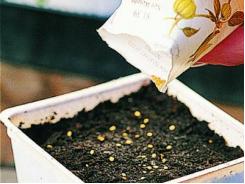Our essential guide to pruning fruit trees

photo: Thomas J. Story
1 Choose wisely.
Before diving into the world of pruning, first make sure you choose a tree for your garden that bears a fruit that you know and love. If you think pomegranate seeds are a hassle to harvest or that apricots have a texture that just isn’t for you, then steer clear! But if nothing makes you happier than the thought of a crisp red Fuji, or an apple pie cooling on your windowsill, the choice should be easy (especially if you have limited real estate in your garden). If you’re lucky enough to have a larger space, however, think of planting varieties that fruit at different times of year--an early-spring apricot, a mid-summer plum, and a fall-bearing apple are a great trio that won’t overwhelm you with too much fruit all at the same time.
2. Prune to a manageable height.
First and foremost, it’s highly recommended that you prune your fruit trees to a manageable height. Although the thought of a 20-foot apple tree may seem appealing, think of the practicalities--even if you manage to reach the ripe apples at the top of the tree, what will you do with that much fruit? Trim to a height that will allow you to easily harvest, prune, net, and manage any pest problems that may arise. If you can’t reach above your head and easily pick fruit from the tree’s tallest branch, it’s likely too tall. Pruning will not only make your life easier, but will save on the cost of purchasing and finding storage space for large ladders and pole pruners. A healthy tree that’s just under six feet will easily provide you and your family with plenty of fruit, as well as lots to share! Please also keep in mind that trees labeled as “semi-dwarf” may be “dwarf” in name only--they’ll need to be pruned regularly, both in the summer and the winter.
3. When it’s warm, prune for height.
As a rule of thumb, try to do your summer pruning around the summer solstice. By the end of June, your tree will be covered in a spring’s worth of vigorous new growth and this is the time to rein it in--don’t let your tree thwart your ambitions to keep it to a manageable height! In some cases, especially with stone fruit such as plums, pluots, and apricots, you’ll need to cut this new growth down by as much as two-thirds. It may seem drastic, but will make a bushier, stronger tree with more branches. Make your cuts (always with a pair of clean, sharpened pruners!) just above a bud of growth and picture that bud as an arrow pointing in the direction where a new shoot will emerge. Never make a cut above a bud that points towards the center of the tree--you don’t want a tangle of criss-crossed branches cluttering up the middle of your tree.
4. When it’s cold, prune for shape:
January or February are the ideal months to do your winter pruning. Try your best to prune during a dry spell without a chance of frost, as fresh cuts on your tree can be particularly susceptible to moisture and cold. Since the majority of fruit trees are deciduous, winter is an excellent time to prune for shape without leaves or fruit cluttering your view. Remove crossing branches, anything that’s growing back into the center of the tree, or limbs that are diseased, broken, or dead. The shape of the tree is up to you, but make sure its center is open and uncluttered--it’s important that air can move freely through the branches once the warm weather returns and the tree is again covered in fruit and leaves.
5. Prune with confidence:
At a certain point, you just have to dive in and make some cuts. It’s easy to get overwhelmed with information about pruning and to be scared to do anything. Just take a deep breath, make a few cuts, and then step back, evaluate, and keep going. Never forget that you’re the boss of your trees, and that they can be the exact shape and height that you want them to be.
Tools

Phối trộn thức ăn chăn nuôi

Pha dung dịch thủy canh

Định mức cho tôm ăn

Phối trộn phân bón NPK

Xác định tỷ lệ tôm sống

Chuyển đổi đơn vị phân bón

Xác định công suất sục khí

Chuyển đổi đơn vị tôm

Tính diện tích nhà kính

Tính thể tích ao




 From start to finish: how to grow your…
From start to finish: how to grow your…  How to start seeds indoors
How to start seeds indoors